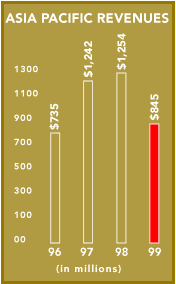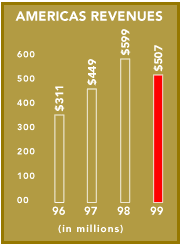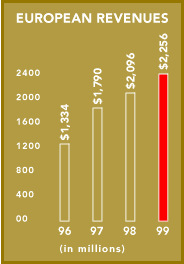![]()
![]()
Sounds like a recipe for disappointment and things certainly were headed in that direction if we hadn't chosen the path of vigilant self-examination. In our life as a public company, we have endured sales declines on several occasions. During those cycles we would put our heads down and plow ahead, firm in the belief that our vision was correct, but the execution may have gone a bit astray.
In fiscal 1999, we recognized that bumps in the road for a $9 billion company have a greater capacity to
 permanently injure than they did a few years back. Our size had become our
greatest challenge. Running the same offense that we did in the past was
not going to put us back on the path of growth.
permanently injure than they did a few years back. Our size had become our
greatest challenge. Running the same offense that we did in the past was
not going to put us back on the path of growth.So if fiscal 1998 was spent in the emergency room, fiscal 1999 was spent partially in post-op and partially in rehab. We put our organization under the microscope, seeking to define what Nike needed to look like on the precipice of a new century. And while we may not feel totally healed, we believe strongly in our future and our ability to make it happen.
We cut operating expenses by almost $200 million, enabling us to bring net income in relatively flat for the year when you factor out the restructuring charges. Every nook and cranny was examined. One result was an additional nine percent reduction in headcount. Not fun stuff, but necessary measures regardless.
We managed our balance sheet, cutting inventories by 14 percent and reducing working capital needs. We generated significant free cash flow, more than enough to pay for our dividends and share repurchase programs.
Looking ahead, we'll continue to look for opportunities to reduce our expenses. There may be less low hanging fruit after last year's cuts, but we'll strive to be lean so that we can remain nimble and in touch with the changing markets in which we operate.
The story in the U.S. was really a tale of two businesses moving in opposite directions. Both NIKE and our retail partners finished fiscal 1998 with excess footwear inventory. That clearly impacted our ability to sell in new footwear in the first half of fiscal 1999,
 resulting
in a double digit sales decline for the first six months. As the inventory
started to clear out by mid-year, consumers reacted positively to our spring
line of footwear, particularly the Tuned Air running shoes. The combination
of cleaner inventories, some cool new shoes, and a more positive retail
environment helped get our U.S. footwear business back on beam by fiscal
year-end. For the first six months of fiscal 2000, futures orders for U.S.
footwear were up three percent, leaving us optimistic that we have weathered
a difficult stretch in that piece of our business.
resulting
in a double digit sales decline for the first six months. As the inventory
started to clear out by mid-year, consumers reacted positively to our spring
line of footwear, particularly the Tuned Air running shoes. The combination
of cleaner inventories, some cool new shoes, and a more positive retail
environment helped get our U.S. footwear business back on beam by fiscal
year-end. For the first six months of fiscal 2000, futures orders for U.S.
footwear were up three percent, leaving us optimistic that we have weathered
a difficult stretch in that piece of our business. Our U.S. apparel business – which exploded from $424 million in fiscal 1995 to $1.56 billion in fiscal 1998 – saw a decline for the first time since 1994. The growth in that three-year stretch put us at the forefront of the U.S. athletic apparel market but it also severely taxed our organizational resources. Throughout the year, the entire athletic apparel market was negatively affected by strong demand for a number of more fashion-oriented brands. We have realigned our organization to be more in sync with how consumers buy athletic apparel but are cognizant that the coming year will be a challenging one.
The dramatic fall off in our Asia Pacific
business at the end of fiscal 1998 pretty much ensured that 1999 was going
to be a painful time. The economic crisis in Asia continued to weigh heavily
on consumers and inventories were swollen, particularly in Japan. So things
started off pretty much as we thought as revenues and, to a lesser degree,
profitability, suffered steep declines in the first half of the year.
Yet by mid-year, inventories, which were perhaps more of a problem than
in the U.S. footwear market, had been reduced to manageable levels and
it began to feel like we had touched bottom.
consumers and inventories were swollen, particularly in Japan. So things
started off pretty much as we thought as revenues and, to a lesser degree,
profitability, suffered steep declines in the first half of the year.
Yet by mid-year, inventories, which were perhaps more of a problem than
in the U.S. footwear market, had been reduced to manageable levels and
it began to feel like we had touched bottom.
By fiscal year-end, there was even cause for some cautious optimism as
futures orders moved back into a positive mode for the first time in 21
months. Two key global sporting events – the 2000 Olympics in Sydney
and the 2002 World Cup in Japan and Korea – will take place in the
region, and there is a great opportunity for these events to raise regional
consumer interest in sport.
We talked earlier about vigilant self-examination. That effort was best
exemplified in our actions in the Asia Pacific region. As part of the
restructuring process begun late in fiscal 1998, we elected to consolidate
our Asia Pacific management team to our world headquarters, effectively
taking a big chunk out of the regional cost structure. Overall, we reduced
costs by about $150 million in the region, but retained an organizational
excellence that will enable us to grow profitably in the years to come.
![]()
 For the first time since the early '90s, our Americas region showed a
decline in revenues. About half of that decrease came in Canada, where
we were affected by many of the same issues that hit our U.S. business.
In addition, the wobbly economic environment in Latin America (that's
starting to sound familiar, isn't it?) hampered our growth, particularly
in Brasil where our independent distributor was forced into bankruptcy
early in the year.
For the first time since the early '90s, our Americas region showed a
decline in revenues. About half of that decrease came in Canada, where
we were affected by many of the same issues that hit our U.S. business.
In addition, the wobbly economic environment in Latin America (that's
starting to sound familiar, isn't it?) hampered our growth, particularly
in Brasil where our independent distributor was forced into bankruptcy
early in the year.
So we adapted. We accelerated our plans to create a wholly owned subsidiary
in Brasil. We developed plans to introduce locally-sourced, lower-priced
footwear into key Latin American markets. And we're working on energizing
the brand in Canada. Y'know, the year in the Americas region was probably
more painful than two paragraphs might convey, but we have a good team
in place to attack the problems in this region and there's a lot of young,
healthy people living there who love sports. We like that equation.
![]()
Finally,
some happy stuff to talk about. Our results in Europe over the
past several years have been quite satisfying. While compounded annual revenue growth of
23 percent over the past four years probably
isn't enough to quench the thirst of day traders out there, we
consider it a very healthy number
that's indicative of how much growth potential remains in our core business.
probably
isn't enough to quench the thirst of day traders out there, we
consider it a very healthy number
that's indicative of how much growth potential remains in our core business.
Just as it was last year, the growth in Europe was driven by apparel.
We cracked the $1 billion mark in apparel for fiscal 1999, a number larger
than total European revenues four years ago.
With revenues topping the $2.2 billion mark, it will be more challenging
than ever to grow our business in Europe. Our size does provide us with
the opportunity for leverage, be it through integrated pan-European campaigns,
inspiring consumers at new Niketowns in London and Berlin, more efficient
use of our Laakdal warehouse or, longer term, using the euro to move towards
price harmonization throughout the region.
On the consumer front, our challenge is to keep our brand fresh and relevant
to young consumers as we grow. We'll continue our City Attack campaigns
with focused advertising in key European markets. And like in the U.S.,
we'll need to successfully navigate the road being blazed by the revolution
in digital communications.
![]()
With all due apologies to our friends who do a nice business selling toothpaste
and soda pop, we're really happy being in the sports business.
A lot of trees were killed this past year as the sports and business media
wrote the death knell for athletes as endorsers. Interesting that we didn't
see too many of those articles after 40 million people watched the U.S.
women capture the World Cup. Or while Mark McGwire was busy crushing Roger
Maris' home run record. Or when Maurice Greene and Hicham El Guerrouj
respectively broke world records in the 100 meters and the mile, track
and field's most prestigious events.
We could go on: Lance Armstrong's marvelous return from cancer to capture
the Tour de France, Tim Duncan and David Robinson taking their dignity
above the rim in the NBA Finals, Pete Sampras capturing his 6th Wimbledon.
Truth is there are great sports moments happening everyday around the
world. Some of them are played out on a global stage while others take
place on school playgrounds, drive- ways and city streets. If our competitors
wish to walk away from that emotion, so be it.
![]()
OK, everyone who knows how e-commerce is going to work out raise your
hand? What's that you say, you're too busy shorting Internet stocks to
think about it? Frankly, we're not sure how this is all going to fall
out either. We do know that the potential for selling consumer products
over the Internet has caused everyone in our industry to revisit some
very basics tenets of their business models and that is always healthy.
We like our brand a lot and we're pretty enthused about this new avenue
for communicating with our consumers. No promises, but we think some neat
stuff is going to happen, and we plan on being part of it.
So, you ask, what's on the road ahead? Growth, we reply, and we say it
with a tad more enthusiasm than we were able to muster at this time last
year. We also recognize that it can't be growth for growth's sake, it
must be profitable and sustainable. To achieve that goal, we cannot operate
like the Nike of old. Making compelling product in footwear, apparel and
equipment remains at the forefront of what we do, but our responsibilities
grow broader as we enter the next century.
We have gotten to this place by leading or failing but always taking chances.
To capture the next leg in our growth, we must be responsive to consumer
needs while helping energize their individual world of sports. In fiscal
1999, we picked ourselves up off the mat. We are back in the game, scarred,
but certainly a bit smarter for the experience. Now it's time for us to
make good things happen. One last thing: Thank you Mr. Bowerman for making
that very first good thing happen.
